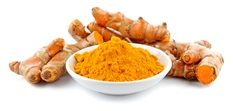Carbon-14 Analysis of Curcumin

Turmeric powder, made from the plant Curcuma longa, consists of several different curcuminoids including curcumin. It has a distinctive yellow color and has various uses including flavoring, coloring, ingredients in cosmetics and as a supplement. As with many other natural ingredients, curcumin is subject to adulteration with the petroleum-derived synthetics and authentication is becoming crucial for manufacturers and suppliers.
Curcumin Adulteration
Naturally sourced curcumin is extracted from turmeric. However, this process is more costly than producing synthetic curcumin from petroleum-derived compounds. Currently many synthetic production routes to curcumin are variations of Pabon’s method which originally used acetyl acetone and vanillin. Acetyl acetone is industrially produced from petrochemicals. Natural vanillin is scarce and expensive to produce but can also be manufactured synthetically with petrochemicals at a much lower cost.
The use of synthetic curcumin in formulations has potential regulatory repercussions. The drafted guidelines in August 2016 by the US Food and Drug Administration (FDA) on new dietary ingredients highlight that synthetic identicals of herbs or botanicals are not the same and therefore do not qualify as a dietary ingredient under 201(ff)(1)(C) of the Federal Food, Drug, and Cosmetic Act.
Given the regulatory implications and the economic incentive for adulteration, with the curcumin market predicted to reach $100 million by 2023, being able to reliably detect the presence of any synthetic curcumin is important for manufacturers and suppliers. Natural source authentication additionally provides a useful marketing tool to gain the trust of consumers.
Detecting Adulteration with Carbon-14 Analysis
Carbon-14 analysis has proven to be an accurate tool to detect adulteration of natural curcumin with the petrochemical-derived synthetic version. According to the American Botanical Council:
The replacement of natural curcumin with synthetic curcumin is a deliberate practice that eludes most spectroscopic and analytical tests. Carbon isotope measurement, requiring a sophisticated accelerator mass spectrometer to measure 14C in the sample, is the most effective method to determine if a curcumin material is plant-derived or of synthetic origin.
Carbon-14, an unstable and weakly radioactive isotope of carbon, enters the carbon cycle from its continual formation in the upper atmosphere. As a result, since living or recently living things are part of the carbon cycle, they will have a known amount of Carbon-14. This radioisotope decays over time, and petroleum and its derivatives are too old such that they will not contain any Carbon-14. Therefore measuring Carbon-14 content gives a clear indication of the natural (biobased) content of a material like curcumin.
Beta Analytic – A Natural Products Testing Laboratory
ISO 17025-accredited Beta Analytic provides high-quality and fast natural product source testing using Carbon-14 analysis according to two standards – ASTM D6866 or ISO 16620-2, which reports biobased carbon content as a fraction of total carbon (TC) or total organic carbon (TOC). Results are reported in 7 business days or less and can be accessed online 24/7 including QA reports and sample photos. A priority service is available for results required in 4 business days or less. For inquiries, please use Beta Analytic’s contact form.
References:
American Botanical Council (ABC), the American Herbal Pharmacopoeia (AHP), and the University of Mississippi’s National Center for Natural Products Research (NCNPR) Botanical Adulterants Prevention Program. Botanical Adulterants Bulletin: Turmeric (Curcuma longa) Root and Rhizome, and Root and Rhizome Extracts. May 2018 (accessed June 2018)
Business Wire. Global Curcumin Market – Forecast to 2023 – Increased Research Focus to Enhance Curcumin Bioavailability Drives Market Growth – Research and Markets. June 2017 (accessed August 2017).
Pabon HJ. A synthesis of curcumin and related compounds. Recueil des Travaux Chimiques des Pays-Bas. 1964;83:379–86.
U.S. Department of Health and Human Services Food and Drug Administration Center for Food Safety and Applied Nutrition. Dietary Supplements: New Dietary Ingredient Notifications and Related Issues: Guidance for Industry. August 2016 (accessed July 2017).
Last Updated June 2021